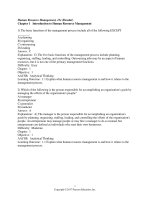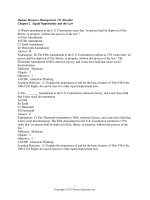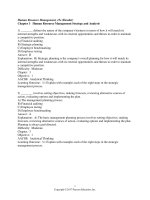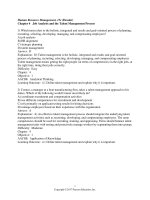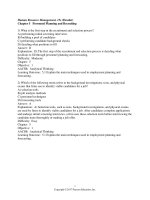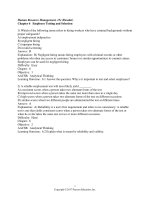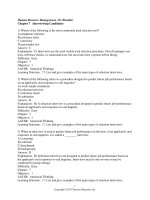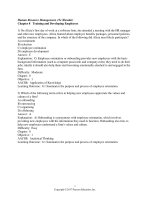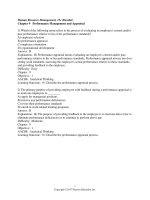99 test bank fundamentals of human resource management 4th edition by noe
Bạn đang xem bản rút gọn của tài liệu. Xem và tải ngay bản đầy đủ của tài liệu tại đây (152.66 KB, 27 trang )
Test Bank Fundamentals of Human Resource Management
4th Edition by Noe
25 Test True – False Questions
9 Test Free Text Questions
65 Test Multiple Choice Questions
(p. 37) Teams that rely on communications technology such as
videoconferences, e-mail, and cell phones to keep in touch and coordinate
activities are referred to as:
1.
A. associate teams.
2.
B. electronic teams.
3.
C. virtual teams.
4.
D. self-managed teams.
5.
E. technological teams.
(p. 34) Which of the following is a trend that is seen in today's highperformance work systems?
1.
A. Mismatches in technical system and social system
2.
B. Employee empowerment in decision making
3.
C. Increase in individual assignments
4.
D. Centralized decision making
5.
E. Reduced reliance on knowledge workers
(p. 31) Which of the following form the majority of the U.S. labor force?
1.
A. African-Americans
2.
B. Whites
3.
C. Hispanics
4.
D. Asians
5.
E. Europeans
(p. 29) Which of the following statements best explains the term "labor
force"?
1.
A. All the permanent employees of an organization.
2.
B. All those who have contracted to work for the company.
3.
C. All the adult members of a population.
4.
D. All the temporary workers of an organization.
5.
E. All the people willing and able to work.
(p. 29) The external labor market in an organization refers to the:
1.
A. contracted workers in the organization.
2.
B. laid-off employees of the organization.
3.
C. individuals who are actively seeking employment.
4.
D. employees who have direct contact with customers.
5.
E. employees of the immediate competitors of the organization.
(p. 30) The fastest growing segment of the labor force is expected to be
between the ages of:
1.
A. 16 to 24.
2.
B. 25 to 35.
3.
C. 36 to 45.
4.
D. 46 to 54.
5.
E. 55 and older.
(p. 39) According to the principles of total quality management:
1.
A. the feedback process should be initiated only after a significant quality
improvement.
2.
B. human resource managers have a diminished role since the emphasis is on
quality alone.
3.
C. only key personnel receive training in quality.
4.
D. errors in a product or service should be prevented before occurrence.
5.
E. internal customers are more valuable than external customers.
(p. 40) A chemical company buys a medical equipment manufacturing
company. This can be referred to as a(n):
1.
A. acquisition.
2.
B. partnership.
3.
C. consolidation.
4.
D. joint venture.
5.
E. strategic alliance.
(p. 37) What effect does the use of employee empowerment have on
recruiting?
1.
A. It has created an international labor market.
2.
B. It has substantially enhanced employment opportunities for women and
minorities.
3.
C. It has shifted the focus away from technical skills to general cognitive and
interpersonal skills.
4.
D. It has significantly reduced recruiting costs.
5.
E. It has made the recruitment process less time consuming than before.
(p. 34-35) According to data published by the Bureau of Labor Statistics,
which of the following occupations is projected to add the most number of
jobs before 2018?
1.
A. Office clerks
2.
B. Registered nurses
3.
C. Pilots
4.
D. Retail salespersons
5.
E. Production workers
(p. 37) How can HRM practices help employee empowerment?
1.
A. Jobs must be designed such that managers have control over business
processes.
2.
B. Mangers should encourage employees to communicate with staff throughout
the organization.
3.
C. Pay and other rewards should reflect employees' loyalty to the organization.
4.
5.
D. Managers should provide feedback only during the employee performance
review.
E. Employees' roles and responsibilities must be narrowed.
(p. 33) Today's employees must be able to handle a variety of
responsibilities, interact with customers, and think creatively. To find
such employees, most organizations are looking for:
1.
A. basic psychomotor skills.
2.
B. employees in competitors' work locations.
3.
C. highly experienced employees.
4.
D. older employees.
5.
E. educational qualifications.
(p. 36) Employee empowerment is defined as:
1.
A. the movement of women and minorities into managerial positions.
2.
B. providing increased salary and benefits to the employees.
3.
C. leading employees by the strength of one's charisma.
4.
D. the act of continually learning and improving one's skills and abilities.
5.
E. giving employees responsibility and authority to make decisions.
(p. 29) Which of the following authorities is responsible for tracking
changes in the composition of the U.S. labor force and in forecasting
employment trends?
1.
A. National Statistics Association
2.
B. Occupational Outlook Bureau
3.
C. U.S. Census Bureau
4.
D. Bureau of Labor Analysis
5.
E. Bureau of Labor Statistics
(p. 32) Managing cultural diversity involves:
1.
A. forming different pay structures for various groups.
2.
B. creating separate career tracks for employees with families.
3.
C. avoiding the use of affirmative action policies.
4.
D. reducing cultural diversity by selective hiring.
5.
E. encouraging career development for women and minorities.
(p. 40) When two companies join forces and become one entity, it is
termed a:
1.
A. partnership.
2.
B. merger.
3.
C. consolidation.
4.
D. joint venture.
5.
E. strategic alliance.
(p. 37) Teamwork is:
1.
A. the assignment of work to groups of employees with various skills who interact
to assemble a product.
2.
B. giving employees responsibility and authority to make decisions regarding all
aspects of product development.
3.
C. having the best possible fit between an organization's social system and
technical system.
4.
D. a companywide effort to continuously improve the ways people, machines, and
systems accomplish work.
5.
E. providing employees the opportunity to grow, thereby achieving organizational
goals.
(p. 31) Employers' support for immigration to the United States can be
attributed to the fact that:
1.
A. there is lack of adequate technology in the country.
2.
B. regulation is not strong enough to control undocumented immigration.
3.
C. qualified technical workers are scarce in the United States.
4.
D. there is increased support from the government also.
5.
E. U.S. workers are not open to innovation.
(p. 33) Which of the following skills are more actively sought by U.S.
employers today?
1.
A. Physical strength
2.
B. Mastery of particular machinery
3.
C. Mathematical skills
4.
D. Ability to perform routine tasks
5.
E. Ability to work with a tool
(p. 36) Skilled knowledge workers:
1.
A. would have less power in the organization.
2.
B. would suffer the most in a slow economy.
3.
C. cannot be replaced easily.
4.
D. never work directly with customers.
5.
E. rarely have a college degree.
(p. 31) Which of the following is the fastest growing category in the U.S.
labor force?
1.
A. African-Americans
2.
B. Australians
3.
C. Whites
4.
D. Asian and other groups
5.
E. Europeans
(p. 34) How has the requirement for creating high-performance work
systems changed?
1.
A. Customers are demanding cheaper, standardized products.
2.
B. Employees prefer implementation of 40-hour work weeks.
3.
C. Competitors are looking for ways to standardize prices in their respective
industries.
4.
D. Employers are looking for ways to tap people's creativity and interpersonal
skills.
5.
E. Customers are demanding standardized products over customized products.
(p. 34) The Bureau of Labor Statistics forecasts that between 2008 and
2018, most new jobs will be in:
1.
A. service occupations.
2.
B. the primary sector.
3.
C. agriculture.
4.
D. the secondary sector.
5.
E. manufacturing.
(p. 37) Full involvement in one's work and commitment to one's job and
company is referred to as:
1.
A. employee engagement.
2.
B. employee empowerment.
3.
C. employee appraisal.
4.
D. job enrichment.
5.
E. job enlargement.
(p. 30) Which of the following is a major problem associated with aging?
1.
A. Older workers present challenges related to costs of health care.
2.
B. Older workers are not capable of learning new technology.
3.
C. Older workers do not want to work.
4.
D. The learning process suffers due to aging.
5.
E. Worker performance suffers due to aging.
(p. 38) Which of the following terms describes a companywide effort to
continuously improve the way people, machines, and systems accomplish
work?
1.
A. Business reengineering
2.
B. Total quality management
3.
C. High-performance work system
4.
D. Optimal performance system
5.
E. Performance management
(p. 36) The reliance on knowledge workers also affects organizations'
decisions about the kinds of people they are recruiting and selecting
leading them to emphasize on:
1.
A. specific job skills.
2.
B. foundation skills.
3.
C. arithmetical skills.
4.
D. general cognitive skills.
5.
E. operative skills.
(p. 30) Which of the following statements about the composition of the
U.S. labor force during the next decade is true?
1.
A. The labor force is expected to grow at a greater rate than at any other time in
U.S. history.
2.
B. The largest proportion of the labor force is expected to be in the 16- to 25-year
age group.
3.
C. For the first time ever, the number of workers under 40 years of age will exceed
the number of workers 40 years of age or older.
4.
D. Despite a small increase in the number of young workers, the overall workforce
will be aging.
5.
E. The total cost of labor in the United States would considerably decrease.
(p. 39) Which of the following statements is NOT consistent with the core
values of TQM?
1.
A. The organization promotes cooperation with vendors, suppliers, and customers
to improve quality and hold down costs.
2.
B. TQM processes are designed to meet the needs of internal and external
customers.
3.
C. Only a few selected managers should receive training in quality.
4.
D. Managers measure progress with feedback based on data.
5.
E. Quality is designed into a product or service so that errors are prevented from
occurring.
(p. 38) Increasingly, HR professionals are being viewed as:
1.
A. legal compliance officers.
2.
B. an administrative unit or function.
3.
C. experts in designing and delivering HR systems.
4.
D. recruitment officers.
5.
E. strategic partners.
(p. 34) Which of the following describes organizations with the best
possible fit between their social system and their technical system?
1.
A. Optimal production systems
2.
B. Holistic management systems
3.
C. Optimal service systems
4.
D. High-performance work systems
5.
E. Total quality management systems
65 Test Bank for Fundamentals of Human Resource
Management 4th Edition Noe Multiple Choice
Questions - Page 2
(p. 40) Some mergers and acquisitions result in _____ within an industry,
meaning that two firms in one industry join to hold a greater share of the
industry.
1.
A. consolidation
2.
B. take-over
3.
C. a joint venture
4.
D. a partnership
5.
E. a strategic alliance.
(p. 50) Independent contractors are:
1.
A. usually full-time company employees.
2.
B. self-employed individuals with multiple clients.
3.
C. people employed by a temporary agency.
4.
D. employed directly by a company for a specific time.
5.
E. people employed by the company to work on an independent project.
(p. 49) Employees realize that many companies are no longer able to
provide long-term employment security. Instead, the employees now
want:
1.
A. increased pay.
2.
B. less demanding work.
3.
C. employability.
4.
D. written employment contracts.
5.
E. additional benefits.
(p. 44) Offshoring is defined as:
1.
A. a practice of having another company provide services.
2.
B. moving operations from the country where a company is headquartered to a
country where pay rates are lower but the necessary skills are available.
3.
C. a method of staffing other than the traditional hiring of full-time employees.
4.
D. a complete review of the organization's critical work processes to make them
more efficient and able to deliver higher quality.
5.
E. the act of acquiring a new company in a distant location or another country in
order to acquire higher market share or growth.
(p. 40) In 1999, Glaxo Wellcome and SmithKline Beecham combined their
businesses to create a new company, GlaxoSmithKline. This is an
example of a(n):
1.
A. acquisition.
2.
B. take-over.
3.
C. partnership.
4.
D. strategic alliance.
5.
E. merger.
(p. 42) When an organization undertakes a complete review of its critical
work processes to make them more efficient and to be able to deliver
higher quality, it is engaging in:
1.
A. outsourcing.
2.
B. high-performance work system design.
3.
C. reengineering.
4.
D. total quality management.
5.
E. reverse engineering.
(p. 48) The relationship between employer and employee can be thought
of in terms of a(n) ____, a description of what an employee expects to
contribute in an employment relationship and what the employer will
provide the employee in exchange for those contributions. Unlike a
written sales contract, this is not formally put into words.
1.
A. employee covenant
2.
B. social agreement
3.
C. psychological contract
4.
D. employment bond
5.
E. explicit agreement
(p. 45) Which of the following terms refers to a computer system used to
acquire, store, manipulate, analyze, retrieve, and distribute information
related to an organization's human resources?
1.
A. Electronic performance support systems
2.
B. e-CRM
3.
C. High-performance work systems
4.
D. Self-service systems
5.
E. HRIS
(p. 50) The use of independent contractors, on-call workers, temporary
workers, and contract company workers, all constitute:
1.
A. outsourcing.
2.
B. alternative work arrangements.
3.
C. consolidation.
4.
D. high performance work systems.
5.
E. offshoring.
(p. 44) Which of the following is the reason why more organizations are
looking overseas to hire talented people?
1.
A. Lack of technology in the U.S.
2.
B. Lack of skilled labor in the U.S.
3.
C. Poor quality of labor in the U.S.
4.
D. Governmental pressure to do so
5.
E. Low cost of labor in foreign countries
(p. 49) The new type of psychological contract has resulted in reduced:
1.
A. creativity.
2.
B. employee compensation.
3.
C. flexibility.
4.
D. training and development opportunities.
5.
E. job security.
(p. 41) The HRM function during downsizing is to terminating the workers
who:
1.
A. are less valuable in their performance.
2.
B. have the least experience in the industry.
3.
C. have spent the least amount of time with the organization.
4.
D. are older than the other employees.
5.
E. are being paid the highest salaries.
(p. 45) An Internet portal is used to:
1.
A. combine data from several sources into a single site.
2.
B. consolidate different HR functions into a single location.
3.
C. process all HR transactions at one time.
4.
D. obtain insight into business trends.
5.
E. improve business decisions.
(p. 50) _____ are employed by a temporary agency; client organizations
pay the agency for the services of these workers.
1.
A. On-call workers
2.
B. Independent contractors
3.
C. Temporary workers
4.
D. Contract company workers
5.
E. Part-time workers
(p. 50) Henry is a human resource consultant who runs and operates his
own business from his home. He is often hired by businesses to present
one- or two-day workshops on various topics within his field of expertise.
Henry is a(n):
1.
A. on-call worker.
2.
B. agent.
3.
C. temporary employee.
4.
D. contract company worker.
5.
E. temporary worker.
(p. 49) Which of the following is a disadvantage of the new psychological
contract?
1.
A. It has resulted in reduced job security.
2.
B. Companies have become less innovative.
3.
C. Work schedules have become less flexible.
4.
D. Employees have less control over how they work.
5.
E. Training and development opportunities have reduced.
(p. 47) Which of the following is an implication of e-HRM for the HRM
practice of analysis and design of work?
1.
A. Job openings can be posted online and candidates can apply for jobs online.
2.
B. Online learning can bring training to employees anywhere, anytime.
3.
C. Online simulations, including tests, videos, and e-mail, can measure job
candidates' ability to deal with real-life business challenges.
4.
D. Employees in geographically dispersed locations can work together in virtual
teams using video, e-mail, and the Internet.
5.
E. Employees can review salary and bonus information and seek information
about and enroll in benefit plans.
(p. 47) If, as a plant manager, you entered the question "Can we change
working hours?" into the company's intranet search and received
feedback on the company's policies regarding work hours, plus state and
federal guidelines, summaries of relevant laws, model documents, and
new reports concerning alternative work schedules, you would probably
be using a(n):
1.
A. virtual team network.
2.
B. performance management system.
3.
C. business-to-business Internet service.
4.
D. self-service system.
5.
E. Internet portal.
(p. 44) When large U.S. software companies like IBM and Microsoft open
facilities in India to take advantage of the highly skilled labor available
there at lower pay rates, they are engaging in:
1.
A. consolidation.
2.
B. outsourcing.
3.
C. empowerment.
4.
D. sustainability initiatives.
5.
E. offshoring.
(p. 45) Which of the following can be used to consolidate different HR
functions into a single location, eliminate redundancy, and reduce
administrative costs?
1.
A. Internet portals
2.
B. Application services
3.
C. Shared service centers
4.
D. Business intelligence systems
5.
E. Electronic performance support systems
(p. 42) As a method of downsizing, early-retirement programs have been
shown to be:
1.
A. humane.
2.
B. linked to greater employee suffering and distress.
3.
C. a better alternative to the "grenade" approach.
4.
D. suited to distinguish clearly between good and poor performers.
5.
E. by far the most effective.
(p. 47) A great deal of HR information is confidential and not suitable for
posting on a Web site for everyone to see. One solution is to set up e-HRM
on ____, which is a network that uses Internet tools but limits access to
authorized users in the organization.
1.
A. a website
2.
B. an intranet
3.
C. third-party services
4.
D. a shared service center
5.
E. Internet portals
(p. 46) What was one of the reasons for the failure of many start-up
Internet-based organizations?
1.
A. The companies were founded by young people.
2.
B. The organization culture was based on policies and procedures.
3.
C. Excessive funding from venture capitalists.
4.
D. Heated competition from established organizations.
5.
E. Lack of governmental support and legal costs.
(p. 47) A system in which employees have online access to information
about HR issues and go online to enroll themselves in programs and
provide feedback through surveys is termed:
1.
A. e-HR management.
2.
B. payroll automation.
3.
C. job enrichment.
4.
D. employee empowerment.
5.
E. self-service.
(p. 46) The processing and transmission of digitized HR information,
especially using computer networking and the Internet, is known as:
1.
A. electronic human resource management.
2.
B. application sharing.
3.
C. electronic performance systems.
4.
D. reengineering.
5.
E. business intelligence.
(p. 41) Which of the following is a challenge for HRM during mergers?
1.
A. Scrutinizing balance sheets
2.
B. Evaluating the financial worth of the new company
3.
C. Developing competitively priced products
4.
D. Developing conflict resolution skills among employees
5.
E. Sustaining the brand image of the company
(p. 45) Employees who take assignments in other countries are called:
1.
A. knowledge workers.
2.
B. immigrants.
3.
C. external employees.
4.
D. expatriates.
5.
E. emigrants.
(p. 48) What is an HR dashboard?
1.
A. A messaging system used by HR managers to communicate with employees.
2.
B. A display of how the company is performing on specific HR metrics.
3.
C. A tool used to measure the profitability and growth rate of the organization.
4.
D. A computer system used to acquire, store, manipulate, analyze, retrieve, and
distribute HR information.
5.
E. A system used to store, analyze, and process the information regarding the
employees of an organization.
(p. 44) The largest number of immigrants to the U.S. workforce are from:
1.
A. Africa.
2.
B. Asia.
3.
C. North America.
4.
D. Europe.
5.
E. Central America.
(p. 45) Which of the following technologies lets a company rent space on a
remote computer system and use the system's software to manage its HR
activities, including security and upgrades?
1.
A. Application service providers
2.
B. Internet portals
3.
C. Shared service centers
4.
D. Business intelligence systems
5.
E. Electronic performance support systems
(p. 45) How does a human resource information system help the
organization?
1.
A. It can be used to scrutinize balance sheets.
2.
B. It can be used to develop new lines of products.
3.
C. It can be used to provide employee coaching.
4.
D. It can help avoid litigation and lawsuits.
5.
E. It can used by salespeople to improve targeting.
(p. 45) A(n) _____ provides insight into business trends and patterns and
helps businesses improve decisions.
1.
A. electronic performance support systems
2.
B. Internet portal
3.
C. shared service center
4.
D. application service provider
5.
E. business intelligence system
(p. 42) Which of the following observations about reengineering is true?
1.
A. It is primarily concerned with production processes.
2.
B. Critical processes are not altered during this process.
3.
C. Changing customer needs and technologies necessitate reengineering.
4.
D. It has no impact on human resource practices and systems.
5.
E. It is an effort to continually improve the ways systems accomplish work.
(p. 42) The practice of having another company provide services is known
as:
1.
A. outsourcing.
2.
B. downsizing.
3.
C. empowerment.
4.
D. benchmarking.
5.
E. reengineering.
25 Test Bank for Fundamentals of Human Resource
Management 4th Edition Noe True - False Questions
(p. 38-39) Total quality management is intended to bring about a
continuous process of quality improvement.
1.
True
2.
False
(p. 31) Individuals who arrive in the United States without meeting the
legal requirements for immigration or asylum are referred to as
undocumented immigrants.
1.
True
2.
False
(p. 49) Employees' job security has increased as a result of the new
psychological contract.
1.
True
2.
False
(p. 37) The use of employee empowerment shifts the recruiting focus away
from general cognitive and interpersonal skills toward technical skills.
1.
True
2.
False
(p. 37) Virtual teams rely on communications technology such as
videoconferences, e-mail, and cell phones to keep in touch and coordinate
activities.
1.
True
2.
False
(p. 34) A large gap exists between the social system and the technical
system in high-performance work systems.
1.
True
2.
False
(p. 44) Offshoring refers to moving the operations from the country where
a company is headquartered to a country where pay rates are lower but
the necessary skills are available.
1.
True
2.
False
(p. 39) One of the core values of TQM is that methods and processes are
designed to meet the needs of internal customers rather than those of
external customers.
1.
True
2.
False
(p. 33) Most organizations are looking for educational achievements to
find employees who can handle a variety of responsibilities, interact with
customers, and think creatively.
1.
True
2.
False
(p. 50) Contract company workers are employed directly by a company.
1.
True
2.
False
(p. 30) It is generally seen that worker performance and learning suffer
heavily as a result of aging.
1.
True
2.
False
(p. 34) The Bureau of Labor Statistics forecasts that between 2008 and
2018, most new jobs will be in manufacturing.
1.
True
2.
False
(p. 38) The traditional role of HRM as primarily an administrative function
has gradually given way to a new role—that of strategic partner.
1.
True
2.
False
(p. 42) According to research, early-retirement programs are one of the
most effective approaches to downsizing.
1.
True
2.
False
(p. 44) A company that operates in the U.S. shifts its warehouses and
operations to a low rent area that is 50 miles away from town. This is an
example of offshoring.
1.
True
2.
False
(p. 36) Skilled knowledge workers would suffer the most in a slow
economy as they have little operational importance in a company.
1.
True
2.
False
(p. 35-36) Knowledge workers in an organization do not work directly with
customers.
1.
True
2.
False
(p. 42) Early-retirement programs are a strategy used by organizations
undergoing downsizing.
1.
True
2.
False
(p. 29) An individual who is actively seeking employment is a part of an
organization's external labor market.
1.
True
2.
False
(p. 51) The globalization of the world economy and the development of ecommerce have reinforced the concept of a 40-hour workweek.
1.
True
2.
False
(p. 49) Under the new psychological contract, organizations expect
employees to contribute time, effort, skills, abilities, and loyalty in return
for job security and opportunities for promotion within the organization.
1.
True
2.
False
(p. 42) An organization's critical work processes are not altered during a
reengineering process.
1.
True
2.
False
(p. 39) Total quality management proposes that every employee in the
organization receive training in quality.
1.
True
2.
False
(p. 40) When forming Citigroup, Citicorp combined its banking business
with Traveller's Group's insurance business. This is an example of a
merger.
1.
True
2.
False
(p. 46) The processing and transmission of digitized HR information is
called electronic human resource management.
1.
True
2.
False
9 Test Bank for Fundamentals of Human Resource
Management 4th Edition Noe Free Text Questions
(p. 42-43) What is outsourcing? What are the trends in HR outsourcing?
Answer Given
Outsourcing refers to the practice of having another company (a vendor, thirdparty provider, or consultant) provide services. Not only do HR departments help
with a transition to outsourcing, but many HR functions are being outsourced. One
study suggests that 8 out of 10 companies outsource at least one human resource
activity, and a more recent study found that 91 percent of U.S. companies have
taken steps to standardize their HR processes to prepare for outsourcing.
(p. 29) Define labor force. Distinguish between internal labor force and
external labor market.
Answer Given
The term "labor force" is a general way to refer to all the people willing and able to
work. For an organization, the internal labor force consists of the organization's
workers—its employees and the people who have contracts to work at the
organization. This internal labor force has been drawn from the organization's
external labor market, that is, individuals who are actively seeking employment.
The number and kinds of people in the external labor market determine the kinds
of human resources available to an organization.
(p. 34-36) Explain the impact of knowledge workers on the requirements
for creating a high-performance work system.
Answer Given
As the nature of the workforce and the technology available to organizations have
changed, so have the requirements for creating a high-performance work system.
Customers are demanding high quality and customized products, employees are
seeking flexible work arrangements, and employers are looking for ways to tap
people's creativity and interpersonal skills. Such demands require that
organizations make full use of their people's knowledge and skill. This has
resulted in increased demand for knowledge workers. Employees whose main
contribution to the organization is specialized knowledge, such as knowledge of
customers, a process, or a profession are referred to as knowledge workers.
Knowledge workers are in a position of power, because they own the knowledge
that the company needs in order to produce its products and services, and they

